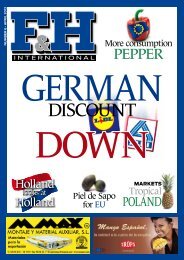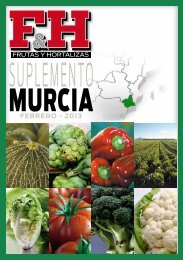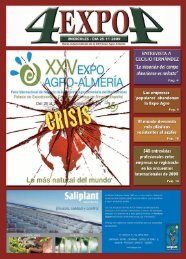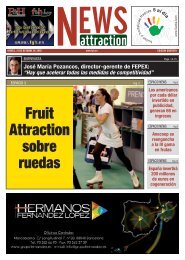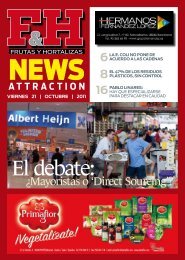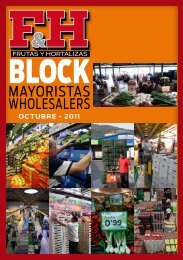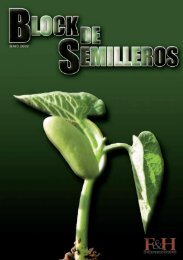Reporting On... - Revista F&H
Reporting On... - Revista F&H
Reporting On... - Revista F&H
You also want an ePaper? Increase the reach of your titles
YUMPU automatically turns print PDFs into web optimized ePapers that Google loves.
The number of samples taken<br />
of every product depend<br />
on the potential health risks<br />
it may pose to consumers. A<br />
look at the top of the ranking<br />
of samples per product<br />
identifies a few of the notorious<br />
problem childs: peppers,<br />
grapes, tomatoes, lettuce,<br />
and strawberries. Especially<br />
the figures for lettuce deserve<br />
a closer look.<br />
Lettuce. Lettuce (‘butterheads’,<br />
i.e. leaving out Iceberg<br />
lettuce, rucola, Romaine<br />
lettuce, etc.) turned out to be<br />
the most problematic of all<br />
product groups included in<br />
the report. In particular, lettuce<br />
from Belgium is one of<br />
no more than two vegetables<br />
(besides Greek rucola) where<br />
the authors of the report go<br />
as far as to explicitely recommend<br />
to look for alternative<br />
origins.<br />
In 2010, Rewe commissioned<br />
analyses of 491 lettuce samples,<br />
the big majority of these<br />
from Germany (285). Two<br />
(Belgian) samples exceeded<br />
ARfD values, 133 contained<br />
residues in concentrations<br />
that added up to aggregate<br />
PRP values of at least 200%;<br />
of these, in 89 cases individual<br />
residues exceeded (by at<br />
least 100%) the corresponding<br />
PRP value.<br />
The average CL was 226%;<br />
the highest CL value, found<br />
in Belgian lettuce, was<br />
4621%. Not a single sample<br />
from Belgium was among the<br />
63 (13%) found to contain<br />
no residues at all. Instead,<br />
all Belgian lettuce samples<br />
contained residues of at least<br />
two different agents, and in<br />
75% of all samples from that<br />
origin, the number of active<br />
substances was between five<br />
and twelve; the average CL<br />
amounted to 497%. (German<br />
lettuce, compared to<br />
Belgian exports, performed<br />
clearly better: an average CL<br />
of 59 per cent; no residues<br />
above ARfD values; 21% of<br />
samples were residue-free;<br />
only 20% of samples contained<br />
more than four active<br />
substances.)<br />
The report points out that,<br />
for all origins, there is an important<br />
difference between<br />
the summer season (fewer<br />
residues and nonconformities)<br />
and winter, when the<br />
conditions are equally adverse<br />
to lettuce growing all<br />
over Europe which is why the<br />
origin cannot really account<br />
for the big differences between<br />
countries. Apart from<br />
recommending to substitute<br />
Belgium for other origins,<br />
the report points out that frequent<br />
sampling and screening<br />
of lettuce from all origins,<br />
especially in winter, must be<br />
given top priority.<br />
Acute vs. chronic health risks.<br />
Of course, any fruit or vegetable<br />
that contains a residue<br />
higher than the ARfD and<br />
therefore poses an immediate<br />
risk to consumers, is<br />
unacceptable, and growers,<br />
traders, and retailers have<br />
to look for ways to identify<br />
and eliminate these products<br />
from the shelves.<br />
That is why several product<br />
groups (peaches, citrus,<br />
grapes, tomatoes, lettuce,<br />
etc.) have to be kept under<br />
close observation. At the<br />
same time, professionals<br />
must not forget the chronic<br />
health risks inherent in fruits<br />
and vegetables that do not<br />
stand out for deviations from<br />
ARfD values or the accepted<br />
contamination levels. To<br />
get a realistic picture of the<br />
contribution of every single<br />
product to the total amount<br />
contamination level all<br />
fruit and vegetables<br />
(average % of<br />
aggregate PRP)<br />
ARfD incompliances (%)<br />
Acute health risk (all<br />
fruit and vegetables;<br />
2007 = 100)<br />
Chronic (consumptionrelated)<br />
health risk (all<br />
fruit and vegetables;<br />
2007 = 100)<br />
Focal Point<br />
Health Safety on the Rise<br />
of residues the average consumer<br />
ingests, the average<br />
consumption quantities 1 per<br />
product have to be taken into<br />
account. This is how we can<br />
see that in 2010 (at least for<br />
consumers who shop their<br />
groceries at Rewe’s) the first<br />
source of ingested residues<br />
really was potatoes, followed<br />
by apples (both 0 ARfD incompliances),<br />
oranges, and<br />
tomatoes. This fact has to be<br />
taken into account when priorities<br />
are set.<br />
(1) The consumption quantities used<br />
include processed food products, that<br />
is to say the fresh produce equivalent,<br />
which in some cases may account for a<br />
high proportion of the total (potatoes,<br />
tomatoes).<br />
2007 2008 2009 2010<br />
117 89 89 58<br />
1.71 1.04 0.58 0,21<br />
100 60 34 12<br />
100 79 71 58<br />
Source: Rewe Group Köln.<br />
F&H International 1 • November 2011<br />
7




